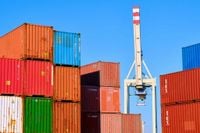VANCOUVER — The ongoing tariff drama created by President Donald Trump has turned economic diversification into a national imperative for America’s northern neighbour. Fortunately, Canada has trade agreements with 60% of the global economy, making it well positioned to lessen its reliance on U.S. markets. But as Canadian governments and companies look to make strategic and long-term investment decisions with these trading partners in mind, Canada must accurately assess where their economies are headed.
Accordingly, a new Clean Energy Canada analysis finds that among Canada’s 10 largest non-U.S. trade partners, all of them have net-zero commitments and carbon pricing systems, and roughly half apply carbon border adjustments on imports and have domestic EV requirements reshaping their car markets. Taken together, these measures send a clear, unmistakable signal. Carbon border adjustments, for example, levy a charge based on the carbon intensity of a good’s production and therefore incentivize low-carbon products from importing nations like Canada.
Meanwhile, the existence of a carbon price and a requirement for more EVs means that a market is weaning itself off fossil fuels, and thus demand for oil and gas will see a decline, while interest in clean energy imports and low-carbon products will increase. A number of think tanks and business groups have analyzed and identified opportunities in Canada’s clean economy, including but not limited to clean electricity generation and transmission, critical minerals, EVs and batteries, low-carbon heavy industry, and value-added agricultural and forest products, all of which are explored in the report.
To realize Canada’s potential, federal and provincial governments should take a number of important steps, including: accelerating regulatory and permitting processes for clean growth projects, recognizing green collar worker credentials across provinces, accelerating the build-out of critical trade, energy, and transportation infrastructure, prioritizing interprovincial electricity grid interties in strategic regions, supporting demand for clean goods that benefit Canadian suppliers, and promoting Canadian businesses abroad and Canada as a destination for investment under the banner of a “Clean Canada” brand.
As The World Next Door concludes, seizing the clean economic opportunity is not about starting over, but about leveraging pre-existing industries and advantages in a way that sets Canada up for a sustainable future.
The economic impact of U.S. President Donald Trump’s tariffs will be in focus as the Bank of Canada is set to announce its overnight interest rate on Wednesday, April 16, 2025. Some analysts expect the central bank to cut its benchmark rate by 25 basis points, bringing it down to 2.5 percent. Others expect the bank to hold the rate steady. A cut would make it the eighth consecutive rate cut by the Bank of Canada.
The Royal Bank of Canada expects the overnight rate to be cut by 25 basis points. “Our forecast for the Canadian economy this year has weakened since March. Tariffs are still expected to hurt Canadian exporters but concerns have also grown around a substantially softer U.S. outlook due to reciprocal tariffs and how that can spill over to impact Canada,” RBC economist Abbey Xu said in a note Tuesday.
Overall inflation eased for Canadians in March, but the end of the GST/HST holiday and Trump’s trade war continues to stress consumers in Canada. Statistics Canada said Tuesday that the annual pace of inflation cooled to 2.3 percent in March, compared to 2.6 percent the month before.
CIBC economist Katherine Judge said, “The easing in price pressures is consistent with the Bank of Canada cutting interest rates by 25bps at tomorrow’s meeting, with the downside risks to growth from the trade war outweighing any upside to inflation from tariffs in our view.”
Other economists, however, are pointing to the possibility of the bank holding the rate steady at 2.75 percent. “If trade tensions continue to escalate, we’re looking at the risk of a stagflationary environment with slower growth and rising prices. With so much uncertainty around global growth—especially with tariffs introduced by the U.S.—we expect the Bank to hold rates steady at tomorrow’s meeting,” Andrew DiCapua, principal economist at the Canadian Chamber of Commerce said.
Bank of Canada governor Tiff Macklem said last month that while Canada’s economy had entered 2025 on “solid footing,” with inflation remaining close to the bank’s two percent target rate since last summer, Trump’s tariffs pose a new challenge. “In recent months, the pervasive uncertainty created by continuously changing U.S. tariff threats has shaken business and consumer confidence. This is restraining household spending intentions and businesses’ plans to hire and invest,” Macklem said.
Macklem added that the trade conflict with the United States is likely to increase inflation in the coming months. “Businesses have lowered their sales outlooks, notably in manufacturing and in sectors that depend on discretionary spending by households,” he said. “Credit has become more difficult to access for some businesses, and with a weaker Canadian dollar, the cost of imported machinery and equipment has risen. As a result of all these trade-related factors, many businesses have scaled back their hiring and investment plans.”
When asked if Canada was staring down the barrel of a recession, Macklem said, “It’s going to depend a lot what the U.S. does with their trade policy.”






